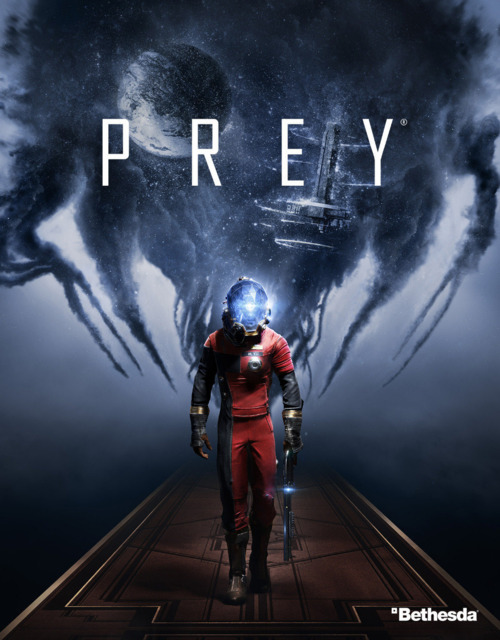A great new IP with an old name
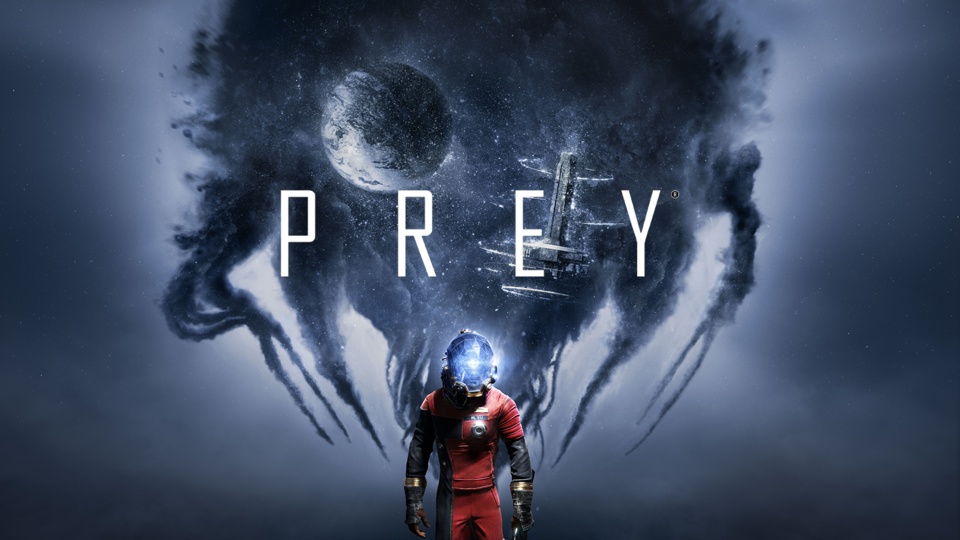
An inconvenient past
When talking about Prey the first thing to get out of the way is how it’s only relation to the original Prey franchise is through a convoluted business justification that could only result from business folk making highly illogical business decisions that probably looked pretty smart in an excel spreadsheet. In short Bethesda acquired the rights to Prey and decided to blow the proverbial dust from this withering license by handing off development to Arkane with apparently the only artistic direction that their game have “Prey” written on the box. There are no Indians, jukeboxes, portals or bounty hunters to be found here, but what is left is another excellent effort from the makers of Dishonored that is the closest we’ll get to System Shock 3 anytime soon.
Taking place in the near future you inhabit the role of scientist Morgan Yu who is engaged in experimental research aboard the Talos 1 space station when things, as is usually the case in videogames, take a turn for the worse. As a result of said complications, which are best left as vague as possible, an alien lifeform known as the Typhon infests the station. In the process of making things "right" you will traverse said station, unlocking it’s various areas in a somewhat non linear fashion, meet station personnel with their own set of problems that only you can solve, and generally try to avoid an unlikely end at the hand of the alien menace.
Exploration
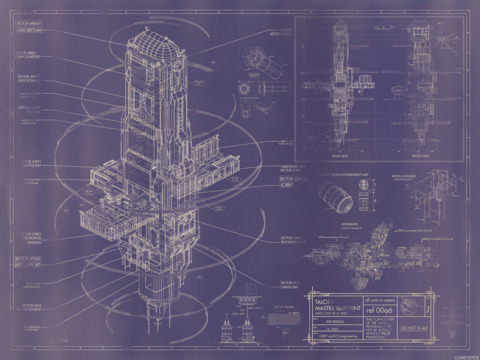
For all intents and purposes what Prey should have been called is Neuroshock. While System Shock dealt with the technological and Bioshock concerned itself with the biological, Prey delves into the neurological aspects of the equation, on one hand balancing such heavy topics as what it is that makes us human while simultaneously on the other hand pursuing the profound goal of unlocking humanity's potential to turn into coffee mugs at will. But what Prey mostly is all about is exploration. After a short, although very clever intro, the space station of Talos 1 opens up as your sandbox and you’re given free reign to go about it as you please. You can go anywhere and accomplish tasks in any way you see fit as long as you have the necessary skills to overcome the roadblocks put in your way. In lieu of classic story exposition you'll piece together most of the narrative from work stations and audio logs that fill in large parts of the backstory as well as provide you with some interesting side stories as well. Throughout your stay you will actually get to know and recognize a lot of the people that had worked on Talos 1 purely from all the correspondence of theirs you’ll have sifted through. These self contained mini-stories actually cleverly connect the entire station through a web of small talk exchanged over future e-mail. You might read about a complaint from a certain employee in the very beginning of the game only to several hours later discover that very same employee in a completely different area with a note or an audiolog that fills in the missing details of their story. These moments help breathe a bit of life into Talos 1, which by now is mostly devoid of it, and in a way humanize what would otherwise be a collection of sterile rooms for you to navigate through. It's up to the player how engaged they want to get with this stuff as there is quite a bit of it. Personally while my eyes typically glazed over when reading e-mails in Deus Ex or the various books in Dishonored, I was strangely invested in learning the fate of these various crewmates. Maybe it's because most exchanges are bite sized and never outstay their welcome, or maybe it's because I was so eager to gleam any hints as to what was actually happening around me, but ultimately I really enjoyed my time staring at virtual monitors - not to mention the achievement for reading all e-mails on the station is aptly named "Press Sneak" most likely referencing the infamous "press sneak fu***s" e-mail concerning Kotakus handling of leaked information.

As Prey is a survival game of sorts you will ransack lockers, desks and crates for any goods that aren’t nailed down. Your survival heavily depends on being prepared and that means making the most of what you find, which is why exploring each area and finding those hidden corners or passwords that open up safes or terminals is so crucial. Most importantly though it’s a ton of fun. Although inventory management is the last thing anyone would think of as "fun" Prey tries and largely succeeds in making it a little more interesting than simply fitting items into a grid. Everything can be used or re-used through the power of recyclers and fabricators. Find another wrench that you don’t need? Toss it in the recycler and get some valuable minerals from it which in turn can be used in the fabricator to print more bullets for your pistol. You'll still get bogged down with too many banana peels from time to time, but a recycler is usually never too far away and the animation of raw materials being spewed out of the receiving end in the form of little cubes never ceases to feel satisfying. With time you'll even gain the ability to fabricate the precious Neuromods, which will eventually lead you down a humorous quest line involving licensing and DRM. In a way the biggest horror of Prey is the realization that even in the future we won't be safe from the horrors of digital rights management.

Arkane have proven with both Dishonored games that they excel at masterfully crafting open areas with multiple pathways, secrets and unconventional solutions to environmental puzzles - and Prey is an exemplification of that prowess. While Dishonored 2 toyed with the idea of connecting zones together in order to create larger levels, Talos 1 is the first time they’ve crafted one large continuous world that can be freely traversed from beginning to end. Not only can you explore the many different zones that make up the station from the cozy Crew Quarters to the industrial Reactor, you can leave the station itself and explore it from the cold vacuum of space, unlocking airlocks that serve as shortcuts for your future travels. The station itself is a beautiful amalgamation of futurism and art deco, where rustic wood paneling goes hand in hand with metal bulkheads and shimmering energy containment fields. Walls are lined with beautifully illustrated posters for fictional movies or the occasional corporate signage warning you about the necessity to keep propriety company tech knowledge to yourself. Prey also handles computer consoles exceptionally well by making them interactable objects rather than static buttons you press and watch your hands miming a typing animation. You input all codes into keypads yourself, click through consoles as if you were navigating a home desktop and execute procedures on machines by manually clicking through the commands in proper order which you’ve most likely learned by reading a manual conveniently left by on a nearby desk. It’s a small touch that goes a long way in giving the player agency in the world and helping build atmosphere. Who knew the one really innovative part of Doom 3 would come back around so many years later, ironically in a game also set in a space station that is being invaded by alien forces.

To help you get around Talos 1 and simply survive, Prey introduces it’s own unique spin on evolving the human genome in the form of Neuromods, which happen to have been undergoing testing before a full commercial release happened back on Earth due to some rather interesting side effects. These precious little hand held devices found throughout Talos 1 inject needles directly into your eyeball - a delicate “prick” as the marketing boys phrase it - and imbue you with skill points to allocate among various skill tree’s. These augmentations in turn help you move around, explore and even fight in more creative ways. See that door? Force it open by investing into the leverage skill which grants you more physical strength. Put points into science to hack a nearby console and open it remotely. Invest in agility so you can jump up to a vent and circumvent the door entirely. Or try one of a dozen other ways that can range from the very straightforward to incredibly convoluted. Along with the augmented abilities Prey also introduces a fascinating weapon/tool called the Gloo Gun. This cannon shoots out grey globs of goo that stick to surfaces and expand, creating convenient man-made stairs and ledges for you to climb on. The Gloo gun adds yet another layer of choice to the already brilliant level design, not to mention that it can also be used to “glue” enemies in place as well. It's no wonder that shortly after games release there were already speedruns being uploaded to YouTube clocking in under the 20 minute mark - for reference my first time through the game took roughly 25 hours. Generally the beauty of Prey is that very often even a completely illogical solution will usually solve a simple problem, all you need is a bit of ingenuity and a few globs of "goo" to do it.
Combat
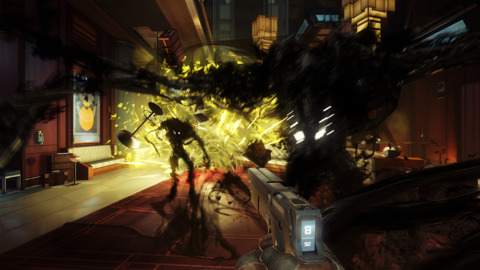
As great as exploring the station is, sifting through e-mails, getting a feel for what has led up to the Typhon outbreak, no self respecting videogame would be complete without wanton violence. The early hours of Prey really justify it’s name as you take on the titular role of an animal on the run from extremely deadly predators. A very unique characteristic of the enemy you face is that they’re able to mimic objects in the environment. That innocuous coffee mug could be in fact a horrifying spider-like monstrosity waiting for you to get close. That box? A Typhon, that lamp, wrench, plant, medkit..probably a Typhon. You very quickly become incredibly paranoid about any new room you step into, and the lack of weapons and resources early on, combined with the rather heavy punch even the smallest of enemies can pack very quickly turn Prey into a survival horror game. These early more subdued parts of baited breath exploration were some of my favorite compared to it's more action filled second act. As the game moves forward and you build on your arsenal of both standard weapons and unique abilities gained from neuromod augmentation the tide of battle start to turn and slowly but steadily the dynamics shift with the hunter becoming the prey. Each weapon can be upgraded and each ability progressively gets stronger as you dump more skill points into it. The ferocious face-hugger mimics turn into more of a nuissance as you gain the ability to dispatch them in a single strike. That said the game is always trying to balance out the power struggle. As you invest more heavily into Typhon abilities, the automated turrets which were previously your greatest allies will now recognize the alien DNA within you and treat you as a hostile. Likewise the more neuromods you use the higher the chance that a menacing behemoth simply referred to as Nightmare will start to stalk you throughout the station. Everything is meant to keep you on your toes which helps the combat from becoming too monotonous.
Of course Prey is far from a twitch shooter the likes of Doom. You aren’t as mobile and the aiming of guns or melee does have a somewhat clunky feel to it very similar to the early Bioshock titles. Combat encounters are meant to be faced in a strategic almost chess like manner. You don’t burst in through the doors guns blazing as that will lead to certain death even very late into the game when you’ve greatly enhanced your Morgan. You sneak into a room, analyze your surroundings, assess the threats and deal with them accordingly. Throw out some nullwave emitters first to prevent a weaver from using it’s long range attacks and send it running in panic; Gloo gun a phantom to momentarily take it out of the fight and then engage your bullet time ability to comfortably take out the quick moving mimics with your wrench (since you obviously need to conserve ammunition). Prey rewards this sort of methodical approach to combat and punishes brash behavior in equal measure. You can spec in a way that will make head-on combat a viable option, increasing your health, stamina and various resistances to elemental attacks, but with some many interesting abilities and options it's much more fun to play a tense game of cat and mouse rather than reduce this innovative game to a rather stiff corridor shooter.
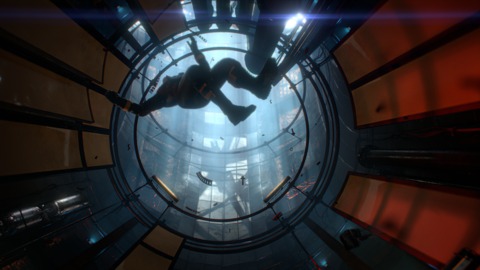
Unfortunately in the pursuit of a bigger more open world Arkane did encounter some stumbling blocks. While Talos 1 is an amazing place to explore, Prey shows it’s full hand a little too early on. About halfway through the experience you’ll have visited all major areas at which point the game will start sending you backtracking to previous locations a little too often. Factor into these travels the fact that enemies repopulate in increasing numbers and more formidable forms, and that tense atmosphere from the early parts of the game goes right out the window, replaced instead with exasperation as you go through one combat encounter straight into another with little to no downtime. As mentioned above, Prey is also not the greatest shooter when you’re trying to run and gun it, so the few moments when you’re put into time sensitive situations end up being more frustrating than need be. Even when you do unlock all the airlocks and activate the main lift, some areas are just a pain to navigate through and Prey has no qualms about asking you to get an item from one side of that station, come back to the other side, and then send you right back where you started - each trip complete with 2-3 loading zones in between. Likewise enemy variety dries up at a certain point and you're left fighting the same few basic types over and over again. Pacing can be said to be one of Preys weakest links, more so than the combat, as the second half of the game tries to up the ante in ways that seem counter-intuitive to Preys strengths.
The power of choice
Paramount to my enjoyment of Prey was the ever present feeling of freedom in approaching the game however I chose to. Much like the Dishonored games before, or even titles such as Deus Ex, the player is given free reign to decide how they want to approach a lot of the situations put before them. Prey can be tackled in a variety of ways in both gameplay and a narrative sense. You can choose to play through the entire campaign without ever using any Typhon abilities. You can choose to do a completely non-lethal playthrough saving all those you encounter, or kill every single NPC whether they're an integral quest giver or not, and still complete the game with an ending that ties into that choice. You can do side quests or beeling the main quests without being forced to grind for abilities, play stealthy or go guns blazing, mix and match. You are asked to make ethical decisions along the way which feel organic and are not immediately labeled as good or evil. Plenty of times when you help someone aboard Talos 1 you are rewarded with the feeling of actually being a decent human being first and foremost. Despite any shortcomings or annoyances I might have encountered along the way, it was primarily this amazing freedom that drove me forward and made my stay so enjoyable.
Fun times in cruel cold space
Overall my time spent with Prey was a really fun and memorable one as I truly got lost in it's world of corporate power struggles, research ethics and Lem-like musings about the nature of humanity. There were of course a few minor hiccups along the way. Some quests were a little unclear, others triggered in awkward ways. Sometimes objective markers tend to get a little screwy and the map system you end up having to fall back on isn’t the best. In typical Arkane style the story builds to an explosive crescendo only to present it’s fascinating conclusion (several endings are possible) in a quick and rather anemic fashion. Which is a shame because the way the game integrates a lot of seemingly benign decisions you make throughout your playthrough is really clever and genuinely surprising.
Prey is a fascinating and highly unique title, that gots baggaged with a decade old name that sadly does it no favors. Just like Firaxis fills the void for folks that crave turn based squad combat, or how Obsidian craft lore rich, isometric RPG’s, Arkane have become the go to developer for people that loved games like Thief for their open world design. Like Dishonored before it Prey is probably not for everyone, but in a sea of sequels and safe bets it’s a bold new IP that does something new and interesting. If you enjoyed the previous titles from this studio then there is a very good chance you will find Prey similarly engaging. For everyone else, do some research, and if at least a few of the core gameplay elements seem like they're up your alley I'd highly recommend checking it out. With a striking aesthetic, clever story and an eerie score from none other than Mick Gordon of Doom fame, Prey is if nothing else a breath of fresh air.
